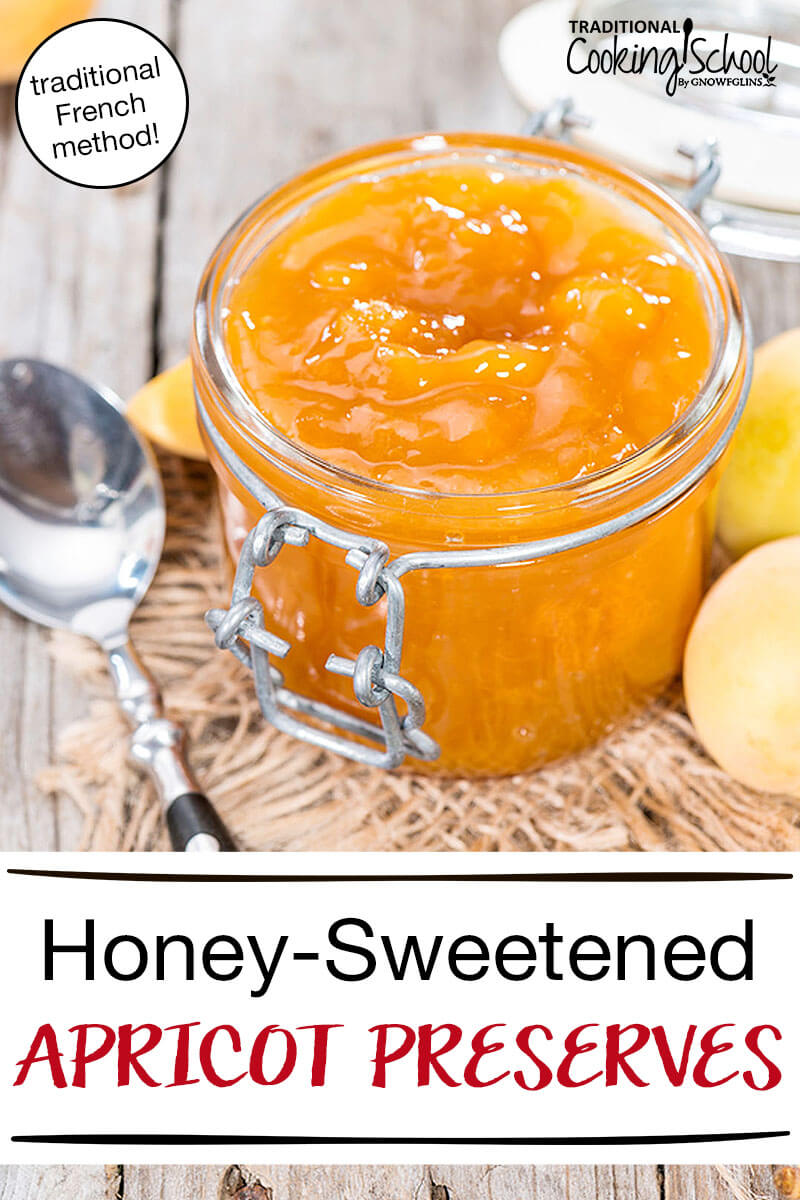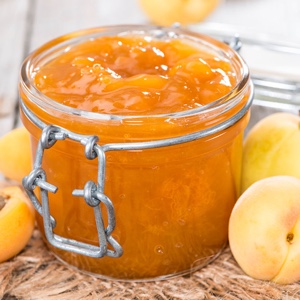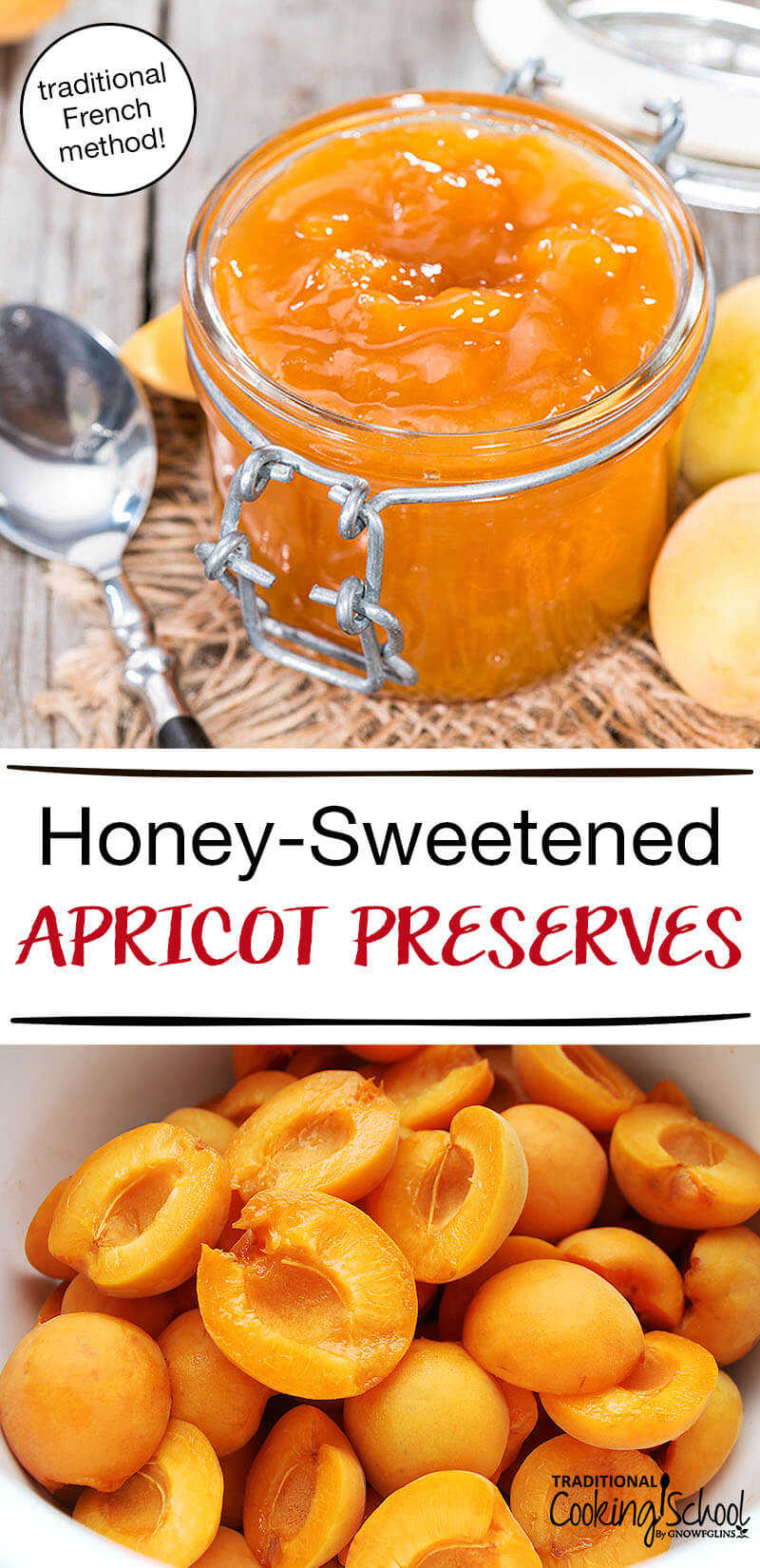
Summertime is for reveling in the heavenly flavors of ripe summer fruit, is it not? Truly, there’s nothing so delicious as a peach in August, or a fresh melon on any hot afternoon!
This recipe is one of my all-time summer favorites. Last year, I shared my recipe for Classic Cherry Clafouti, and I would be hard-pressed to choose a favorite between the two. However, perhaps this Apricot Preserves recipe has an advantage because we will still be enjoying these summer flavors in late October, when we’re bundled in wool sweaters and lighting the wood stove each morning. Who doesn’t need a little golden cheer in those increasingly dark days?
Based on the traditional French method of making apricot preserves and apricot butter, this recipe is one I look forward to making each summer. I hope you enjoy it as thoroughly and delightedly as I do.
Happy late summer!

Apricot Preserves
Ingredients
- 3 pounds apricots
- 1 cup pure water
- 2 cups raw honey
- 3 tablespoons lemon juice
- 1/4 cup almonds
Instructions
-
Wash the apricots, then cut them open and remove the pits, but do not discard them.
-
Coarsely chop the apricots and set them aside.
-
Take three pits and crack them open by laying the long side of a large knife against each one and smashing it with your hand.
-
Take out the almond-like nut inside and then coarsely chop them along with the almonds and wrap altogether in one thin layer of cheesecloth, tying the little packet securely.
-
In a large, heavy-bottomed saucepan, bring the water and honey to a full, rolling boil over medium-high heat.
-
Add in the apricots, lemon juice, and nuts, and continue to cook uncovered at a heavy simmer until the apricots are very soft and the mixture is syrupy.
-
This should take about 30 minutes.
-
Stir occasionally to be sure the mixture isn’t sticking to the bottom and skim off any foam that forms on the top.
-
Test the doneness of the preserves by spooning a bit of the syrup onto a cold plate.
-
If it gels, it’s done. Remove from the heat and spoon into jars, discarding the pouch of nuts.
-
Store in the refrigerator for up to 3 months.
-
Note that this recipe does not safely can due to the honey.
Recipe Notes
Apricot Butter
Makes approximately 3 or 4 cups. (This depends on how long you let it reduce.)
Follow the instructions above, reducing the heat slightly as the mixture thickens, and continue to let the mixture simmer until very thick (about 1 hour total).
Stir frequently to keep it from sticking or burning.
Scrape the apricot mixture into a food processor and let cool slightly, then purée until very smooth.
Transfer the apricot butter to jars and let cool completely.
Store in the refrigerator for up to 3 months.
Note that this recipe does not safely can due to the honey.
Enjoy! What do you love to make with apricots?
We only recommend products and services we wholeheartedly endorse. This post may contain special links through which we earn a small commission if you make a purchase (though your price is the same).



This sounds wonderful! Can it be frozen?
Yes! Both the preserves and the apricot butter can be frozen. 🙂
Enjoy!
This sounds so good – I love the idea of using the “whole” fruit in such a way. I may try it with peaches!
I am confused why this can’t be canned. I have some canning recipes that use honey. Why won’t it work with this recipe? Kathryn
You can certainly find good USDA approved recipes for apricot jam and canned apricots (and apricot salsa and chutney). I suspect this recipe hasn’t been tested for safety. A quote from “So Easy To Preserve” the USDA approved canning guide (available online) says, “In general, up to one-half of the sugar may be replaced by corn syrup or mild-flavored honey. A larger proportion of corn syrup may be used if a very bland, light colored type is selected.” p. 35
That seems to suggest that honey wouldn’t be a problem provided you like the flavor. Sugar helps keep the color and texture of canned good appealing. It helps fruits from becoming mushy and bland by pushing some of the water out. But it isn’t a necessity. You can use a very light 10% syrup (only 1/2 cup sugar to a quart of liquid) to a heavy 50% syrup of 4 cups of sugar to a quart of water. If you are going to eat the canned apricots soon, the light syrup is fine. If you are planning for longer term storage, you might want to use the heavy syrup and then you could soak the apricots in water to remove some of the extra sugar and use the syrup to flavor other treats . . .
That’s a great question, Kathryn!
The only reason I mention this recipe *can’t* be canned is to err on the side of caution, as if honey is in the recipe and the jars end up sitting for more than a year or two, there is the possibility that botulism spores will grow and the botulism toxin can bloom.
This risk is incredibly small, so usually I wouldn’t make a wide-sweeping statement like “this food cannot be canned” due to such a small risk, except that the Clostridium botulinum toxin is extremely dangerous even in tiny amounts, so basically I’m playing it “safe rather than sorry” when presenting the recipe publicly. Other recipes, as you mention, have chosen not to make that statement, which is totally fine – again, I merely chose to err on the side of caution.
To be totally honest, I myself DO can this recipe, so like your other recipes you certainly can do so, but just know the risks and eat the food within 6-12 months.
I hope that helps!
(And enjoy! It’s super-yummy. 🙂 )
While three apricot kernels may not be a lethal dose of cyanide, toxic reactions occur at low-dose levels. Even if the kernels are only infused into the preserves, I think I’ll omit that ingredient. http://ispub.com/IJH/9/2/10959
Yes, you’re exactly right on all three fronts:
1. Yes, apricot kernels contain amygdalin, which the body converts to cyanide.
2. Yes, heat-treating amygdalin does destroy the toxin so the body no longer converts it to cyanide. The amygdalin is also partially neutralized when eating the apricot fruit with the pit. (The largest danger is in eating several raw apricot pits all in one sitting without also eating the apricot.) And that’s also assuming you eat the whole pit – in this case, “infused” is exactly the right description.
3. And yes, it’s absolutely okay to leave the apricot pits out and just use the almonds.
Also, the reason I’ve included the apricot pits in this recipe even though I know about the presence of amygdalin is not only because of the lovely extra almond flavor it imparts but because this is the traditional French method that’s been used for hundreds of years (the cookbook from the 1700s in which I first saw the recipe called for using 5-6 times the number of apricot pits and I scaled them back due to this concern).
But again, if you don’t want to use them, that’s TOTALLY your prerogative and you can totally skip them. 🙂
Thanks for a great comment.
I think it’s also helpful to consider that many things in small amounts are healthy even though in larger amounts they are dangerous. When something has been done traditionally, there may be a benefit to it . . . particularly if it tastes good to us. While in some cases our bodies can be tricked into eating foods that ‘taste good’ – like sugars, salts and fats in processed foods – if something tastes good to us, it may also be that our bodies evolved, or were created if you prefer, to want that thing since it is ultimately a healthy contribution to our lives. Even bitters and sours have a charm in their place . . . and health benefits in small amounts. 😉
That’s an excellent point. Thank you for that reminder. 🙂
Approximately how many jars of the preserves does this yield? Thanks!
The recipe makes approximately 6 cups, so if you use pint-size jars it makes three jars and if you use half-pint jars it makes six jars.
These sound delicious! I don’t see any apricot skins in the picture, but the recipe doesn’t include peeling them. Could you clarify for me – peel or don’t peel? Thank you.
No need to peel! The skins soften and break apart just like the rest of the fruit while cooking.
I hope that helps! 🙂
I hope it is not too late to ask a question since this was in 2015. But due to allergy to almonds, is it necessary for the recipe to use them or can I swith with another nut (cashew, maybe) or omit them altogether?